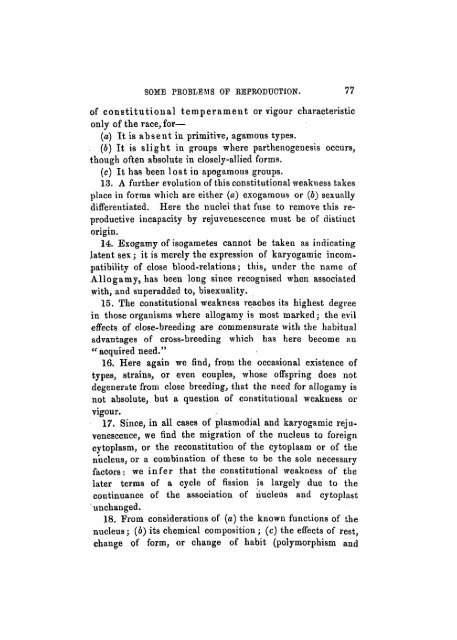Some Problems of Reproduction: a Comparative Study of ...
Some Problems of Reproduction: a Comparative Study of ...
Some Problems of Reproduction: a Comparative Study of ...
Create successful ePaper yourself
Turn your PDF publications into a flip-book with our unique Google optimized e-Paper software.
SOME PROBLEMS OF REPRODUCTION. 77<br />
<strong>of</strong> constitutional temperament or vigour characteristic<br />
only <strong>of</strong> the race, for— ;<br />
(a) It is absent in primitive, agamous types.<br />
(b) It is slight in groups where parthenogenesis occurs,<br />
though <strong>of</strong>ten absolute in closely-allied forms.<br />
(c) It has been lost in apogamous groups.<br />
13. A further evolution <strong>of</strong> this constitutional weakness takes<br />
place in forms which are either (a) exogamous or {b) sexually<br />
differentiated. Here the nuclei that fuse to remove this reproductive<br />
incapacity by rejuvenescence must be <strong>of</strong> distinct<br />
origin.<br />
14. Exogamy <strong>of</strong> isogametes cannot be taken as indicating<br />
latent sex ; it is merely the expression <strong>of</strong> karyogamic incompatibility<br />
<strong>of</strong> close blood-relations; this, under the name <strong>of</strong><br />
Allogamy, has been long since recognised when associated<br />
with, and superadded to, bisexuality.<br />
15. The constitutional weakness reaches its highest degree<br />
in those organisms where allogamy is most marked; the evil<br />
effects <strong>of</strong> close-breeding are commensurate with the habitual<br />
advantages <strong>of</strong> cross-breeding which has here become an<br />
"acquired need."<br />
16. Here again we find, from the occasional existence <strong>of</strong><br />
types, strains, or even couples, whose <strong>of</strong>fspring does not<br />
degenerate from close breeding, that the need for allogamy is<br />
not absolute,, but a question <strong>of</strong> constitutional weakness or<br />
vigour.<br />
17. Since, in all cases <strong>of</strong> plasmodial and karyogamic rejuvenescence,<br />
we find the migration <strong>of</strong> the nucleus to foreign<br />
cytoplasm, or the reconstitution <strong>of</strong> the cytoplasm or <strong>of</strong> the<br />
nucleus, or a combination <strong>of</strong> these to be the sole necessary<br />
factors: we infer that the constitutional weakness <strong>of</strong> the<br />
later terms <strong>of</strong> a cycle <strong>of</strong> fission is largely due to the<br />
continuance <strong>of</strong> the association <strong>of</strong> nucleus and cytoplast<br />
unchanged.<br />
18. From considerations <strong>of</strong> (a) the known functions <strong>of</strong> the<br />
nucleus; (i) its chemical composition; (c) the effects <strong>of</strong> rest,<br />
change <strong>of</strong> form, or change <strong>of</strong> habit (polymorphism and

















